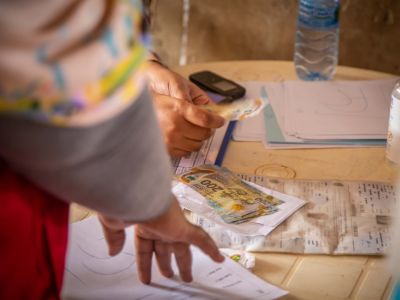With the Grand Bargain making the first global push for CVA to become systematically considered, 52 donors and aid organizations including UNICEF committed to increase their use and coordination of CVA. At first sight, it's impressive to see the growth in volume of CVA since the last report in 2020: from US$6.6 billion to US$10 billion in 2022. Yet, much of this growth can be attributed to an overall increase in humanitarian funding: when volumes of CVA are considered as a proportion of international humanitarian assistance, the increase is very small - just 0.3% since 2020 (a rise to 20.6% in 2022 from 20.3% in 2020). CVA can and should be a much higher proportion of humanitarian assistance - reaching 30% to 50% of international humanitarian assistance if used when appropriate. Therefore, there is still significant space for increasing the share of CVA in international humanitarian assistance and for improving the overall coordination of CVA and clusters can play a key role in this.
This module explores the role of a sector coordination team in promoting the use of CVA. It explores what information is need in order to integrate CVA in cluster/ sector/ areas of responsibility (AoR) activities, the actions that a coordination team can take to do this, and identifies areas of inter-cluster cooperation.
This course is also available in French and Spanish.
Learning objectives
By the end of the module, you should be able to:
- Describe information needed for the integration of Cash and Voucher Assistance (CVA) in cluster/ sector/ AoR activities and processes,
- Explain how to integrate CVA in coordination throughout the Humanitarian Programme Cycle (HPC) and in cluster/ sector/ AoR work beyond the HPC,
- Identify areas for inter-cluster cooperation to increase the flexibility, efficiency and effectiveness of CVA,
- Identify actions to be taken by coordination teams to increase the use of CVA by cluster/ sector/ AoR partners.
Audience
This module targets primarily Cluster/AoR Coordination Teams (coordinators and IMOs) from the UNICEF-led clusters and AoR. This module is also suitable for staff of organisations members of any cluster/sector/AoR.
Length
It should take you about 80 minutes to complete this self-paced course.
Methodology
This course is composed of a single short self-paced animated module, including various examples and activities.
Structure
Introduction
Lesson 1: Information needs
Lesson 2: Cash and Voucher Assistance in the Humanitarian Programme Cycle
Lesson 3: Inter-sectoral synergies
Lesson 4: Reflection and commitment to action
Summary
Suggested preliminary learning
To get the most out of this module, we recommend you have a basic knowledge of CVA fundamentals. If you feel you would benefit from further learning on CVA fundamentals, you might want to take either of the following modules before completing this module:
Cash Learning Partnership (CaLP) course
UNICEF Humanitarian Cash Transfers (HCT) online training
Suggested further learning
CaLP Practical Guide for Market Analysis
Cash and Voucher Assistance in EiE
